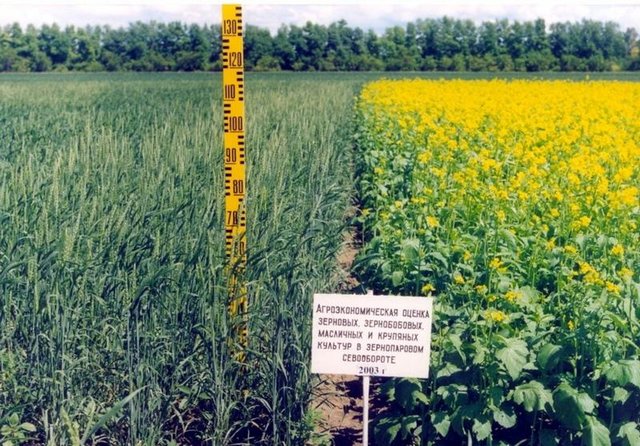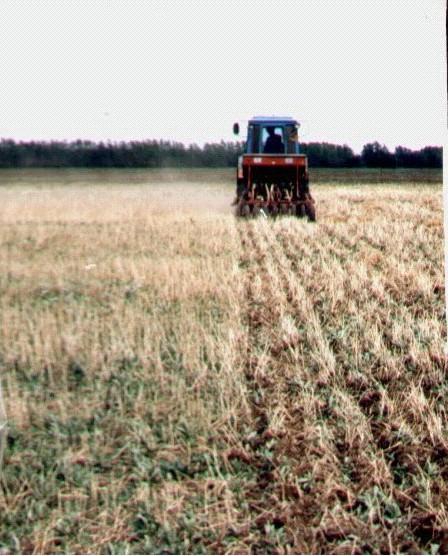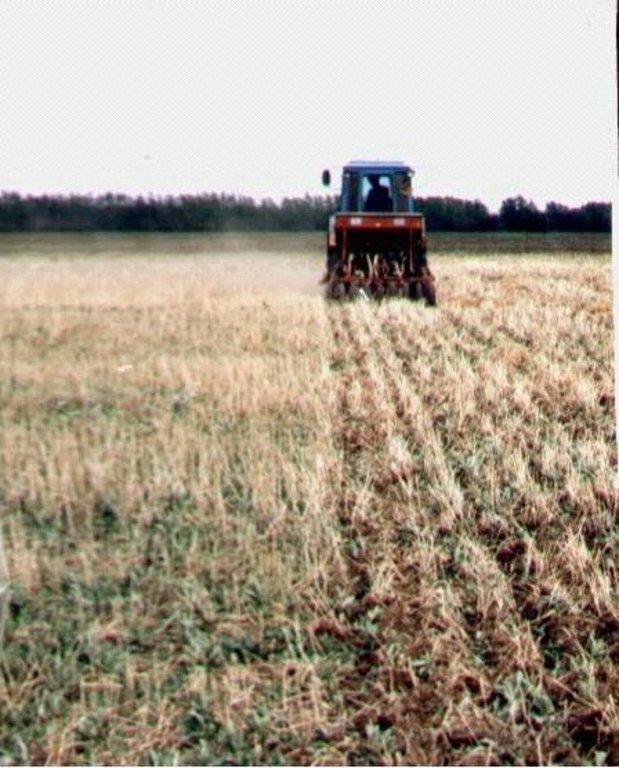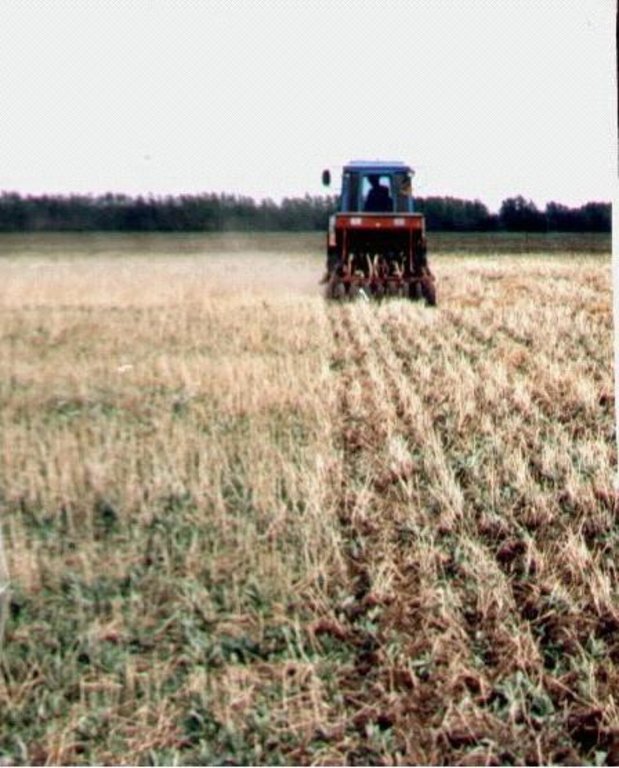Crop on the stubble background [Kazakhstan]
- Création :
- Mise à jour :
- Compilateur : Ervin Gossen
- Rédacteur : –
- Examinateur : Fabian Ottiger
approaches_2363 - Kazakhstan
Voir les sections
Développer tout Réduire tout1. Informations générales
1.2 Coordonnées des personnes-ressources et des institutions impliquées dans l'évaluation et la documentation de l'Approche
1.3 Conditions relatives à l'utilisation par WOCAT des données documentées
Le compilateur et la(les) personne(s) ressource(s) acceptent les conditions relatives à l'utilisation par WOCAT des données documentées:
Oui
1.4 Références au(x) questionnaire(s) sur les Technologies de GDT

Soil-protective minimal technology of the tillage and sowing [Kazakhstan]
The minimal tillage for cultivation of grain crops (the second and third culture after fallow).
- Compilateur : Ervin Gossen
2. Description de l'Approche de GDT
2.1 Courte description de l'Approche
Stubble crop for cultivation of grain crops (spring wheat).
2.2 Description détaillée de l'Approche
Description détaillée de l'Approche:
Aims / objectives: Crop on the stubble includes. 1) In the spring May 15-25, without special preparations that is on stubble, crop of grain crops is made. 2) Crop is made by stubble seeder. 3) Depth of closing up of seeds of 6-8 centimeters. 4) Norm of seeding is 180 kg per 1 ha. 5) Productivity on stubble is 11,5 centner/ha. The given approach prevents crops from wind and water erosion, goes moisture accumulation in a soil cover and accumulation of organic. Problem of soil degradation is especially sharp in North Kazakhstan, zone of the grain agriculture. For the period of the long-term plugging of virgin land the content of humus has decreased by 5-20% and more. 1.2 billion tons or 28.3% from 4.3 billion tons of the humus stocks of the arable layer (0-25 sm) are irrevocable lost because of mineralizing the organic substance, subtraction with a crop, water and wind erosion. In 70th years in Kazakhstan have developed and introduced soil-protective system of agriculture due to wich has been stopped soils erosion and also the productivity is essentially increased. Before introduction of soil-protective system the productivity in northern Kazakhstan made of 5-7c/ha. After introduction of soil-protective system of agriculture the productivity has raised up to 12-15 c/ha. One of the elements of soil-protective system of agriculture ??¡§ are crop on stubble. In the conditions of Kazakhstan, the plowing and crop should be carried out with preservation of stubble in a fallow field once for rotation. It promotes preservation and rational use of the vegetative rests and moisture reduction of industrial expenses and also increase in productivity of grain crops.
2.3 Photos de l'approche
2.5 Pays/ région/ lieux où l'Approche a été appliquée
Pays:
Kazakhstan
Région/ Etat/ Province:
Northern Kazakhstan
2.6 Dates de début et de fin de l'Approche
Indiquez l'année de démarrage:
1976
2.7 Type d'Approche
- traditionnel/ autochtone
2.8 Principaux objectifs de l'Approche
The Approach focused on SLM only (Herbicides, moisture accumulation, crop rotation)
Prevention of wind and water erosion of soils, increase in productivity of grain crops in a steppe zone of Kazakhstan, preservation of moisture accumulation.
The SLM Approach addressed the following problems: Prevention of water and erosion on an arable land.
2.9 Conditions favorisant ou entravant la mise en œuvre de la(des) Technologie(s) appliquée(s) sous l'Approche
normes et valeurs sociales/ culturelles/ religieuses
- entrave
Treatment through the SLM Approach: Shortage of financial assets.
disponibilité/ accès aux ressources et services financiers
- entrave
Cooperation of farms.
Treatment through the SLM Approach:
cadre juridique (régime foncier, droits d'utilisation des terres et de l'eau)
- favorise
The existing land ownership, land use rights / water rights moderately helped the approach implementation: The property rights to the ground promote more operatively to make decision at land users on introduction of the approach
- entrave
The old worn out park of the agriculture technique.
Treatment through the SLM Approach:
connaissances sur la GDT, accès aux supports techniques
- entrave
The cooperative approach of farmers to use of technique.
Treatment through the SLM Approach:
3. Participation et rôles des parties prenantes impliquées dans l'Approche
3.1 Parties prenantes impliquées dans l'Approche et rôles
- exploitants locaux des terres / communautés locales
Working land users were mainly men (Assosiation of separate farms where the basic volume of agriculture works are carried out by men)
Men participated basically. Work cycles of a grain husbandry are served by men
- gouvernement local
- gouvernement national (planificateurs, décideurs)
Institutions of local government
3.2 Participation des exploitants locaux des terres/ communautés locales aux différentes phases de l'Approche
| Participation des exploitants locaux des terres/ communautés locales | Spécifiez qui était impliqué et décrivez les activités | |
|---|---|---|
| initiation/ motivation | passive | public meetings; Meetings of farmers |
| planification | passive | workshops/seminars; Popularization of the approach |
| mise en œuvre | auto-mobilisation | responsibility for major steps; Personal interest of farmers |
| suivi/ évaluation | aucun | |
| Research | aucun |
3.4 Prises de décision pour la sélection de la Technologie/ des Technologies
Indiquez qui a décidé de la sélection de la Technologie/ des Technologies à mettre en œuvre:
- principalement les spécialistes de la GDT, après consultation des exploitants des terres
Expliquez:
Necessity for preservation of fertility of the grounds and struggle against erosion.
Decisions on the method of implementing the SLM Technology were made by mainly by land users supported by SLM specialists. Introduction
4. Soutien technique, renforcement des capacités et gestion des connaissances
4.2 Service de conseils
Les exploitants des terres ont-ils accès à un service de conseils?
Oui
Spécifiez si le service de conseils est fourni:
- dans les champs des exploitants?
Décrivez/ commentez:
Recommendations on system of conducting of an agri; Key elements: Distribution of methodical manuals, Distribution of agromelioratives directories; 1) Advisory service was carried out through: By personal contact 2) Target groups for extension: land users; Activities: Seminars, conversations, joint introductions of the approach
Advisory service is inadequate to ensure the continuation of land conservation activities; The state structures and services of training are not present
4.3 Renforcement des institutions (développement organisationnel)
Des institutions ont elles été mises en place ou renforcées par le biais de l'Approche?
- oui, beaucoup
Spécifiez à quel(s) niveau(x), ces institutions ont été renforcées ou mises en place:
- local
Précisez le type de soutien:
- équipement
4.4 Suivi et évaluation
Le suivi et l'évaluation font ils partie de l'Approche? :
Oui
Commentaires:
bio-physical aspects were regular monitored through observations
economic / production aspects were regular monitored through observations
ecological aspects were regular monitored through observations
There were few changes in the Approach as a result of monitoring and evaluation: The methodical approach remains constant. Changes have been brought in a technological part the design of a seeder was improved.
4.5 Recherche
La recherche a-t-elle fait partie intégrante de l’Approche?
Oui
Spécifiez les thèmes:
- économie/ marketing
- écologie
- technologie
Donnez plus de détails et indiquez qui a mené ces recherches:
1.Selection of grades of the grain crops. 2.Designing and creation of technique (seeders SZS-2). 3.Development of recommendations on conducting a grain husbandry in dried steppe and steppe zone.
Research was carried out both on station and on-farm
5. Financement et soutien matériel externe
5.1 Budget annuel de la composante GDT de l'Approche
Si le budget annuel précis n'est pas connu, indiquez une fourchette:
- < 2 000
Commentez (par ex. principales sources de financement/ principaux bailleurs de fonds):
Approach costs were met by the following donors: government (national): 100.0%
5.2 Soutiens financiers/ matériels fournis aux exploitants des terres
Les exploitants des terres ont-ils reçu un soutien financier/ matériel pour la mise en œuvre de la Technologie/ des Technologies?
Oui
5.3 Subventions pour des intrants spécifiques (incluant la main d'œuvre)
- équipement
| Spécifiez les intrants subventionnés | Dans quelle mesure | Spécifiez les subventions |
|---|---|---|
| machines | en partie financé | |
5.4 Crédits
Des crédits ont-ils été alloués à travers l'Approche pour les activités de GDT?
Non
6. Analyses d'impact et conclusions
6.1 Impacts de l'Approche
Est-ce que l'Approche a aidé les exploitants des terres à mettre en œuvre et entretenir les Technologies de GDT?
- Non
- Oui, un peu
- Oui, modérément
- Oui, beaucoup
The approach considerably reduces erosion of the grounds
Did other land users / projects adopt the Approach?
- Non
- Oui, un peu
- Oui, modérément
- Oui, beaucoup
The given approach is component of SWC on the minimal soil tillage
6.3 Durabilité des activités de l'Approche
Les exploitants des terres peuvent-ils poursuivre ce qui a été mis en œuvre par le biais de l'Approche (sans soutien extérieur)?
- oui
6.4 Points forts/ avantages de l'Approche
| Points forts/ avantages/ possibilités du point de vue de l'exploitant des terres |
|---|
| Maintenance of guaranteed crops (How to sustain/ enhance this strength: The same) |
| Maintenance of guaranteed incomes (How to sustain/ enhance this strength: The same) |
| Increase of fertility of the grounds (How to sustain/ enhance this strength: Regular application of SWC approaches) |
| Reduces danger of display of water and wind erosion (How to sustain/ enhance this strength: Regular application of SWC approaches) |
| Points forts/ avantages/ possibilités du point de vue du compilateur ou d'une autre personne ressource clé |
|---|
| Provides a guaranteed crops (How to sustain/ enhance this strength: Ecological propagation and education) |
| Increase of fertility of the grounds (How to sustain/ enhance this strength: To expand the areas of application of SWC approach) |
| Decrease of eroded lands (How to sustain/ enhance this strength: To expand an area of application of SWC approach) |
6.5 Faiblesses/ inconvénients de l'Approche et moyens de les surmonter
| Faiblesses/ inconvénients/ risques du point de vue de l’exploitant des terres | Comment peuvent-ils être surmontés? |
|---|---|
| Ecological limitation of SWC approach | Investments are necessary |
| Faiblesses/ inconvénients/ risques du point de vue du compilateur ou d'une autre personne ressource clé | Comment peuvent-ils être surmontés? |
|---|---|
| Lack of means at small farmers | Cooperation of farms and infusing of investments |
7. Références et liens
7.1 Méthodes/ sources d'information
- visites de terrain, enquêtes sur le terrain
- interviews/entretiens avec les exploitants des terres
7.2 Références des publications disponibles
Titre, auteur, année, ISBN:
Gossen E.F. Without rotation of layer, Almaty 2000 ySoil-protective agriculture Baraev A.I., Moscow 'Floc' 1975 y
Disponible à partir d'où? Coût?
SPC for Grain Husbandry of the Baraev???s name 15$SPC for Grain Husbandry Baraev A.I. 10$
Titre, auteur, année, ISBN:
Soil-protective agriculture Baraev A.I., Moscow 'Floc' 1975
Disponible à partir d'où? Coût?
SPC for Grain Husbandry Baraev A.I. 10$
Liens et modules
Développer tout Réduire toutLiens

Soil-protective minimal technology of the tillage and sowing [Kazakhstan]
The minimal tillage for cultivation of grain crops (the second and third culture after fallow).
- Compilateur : Ervin Gossen
Modules
Aucun module trouvé




